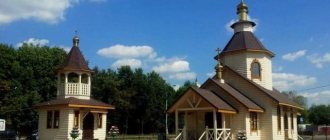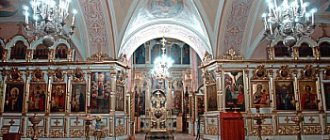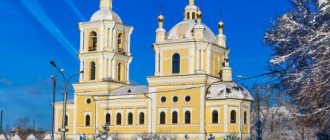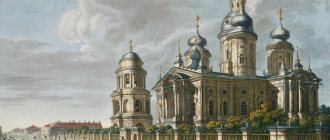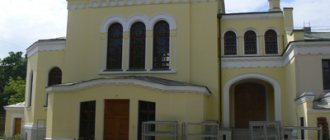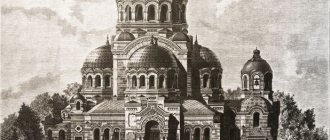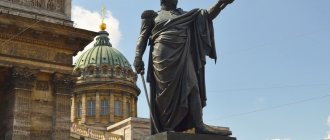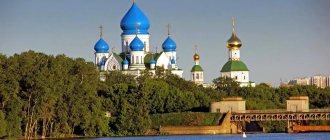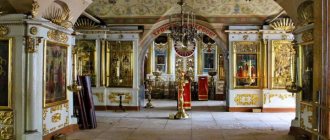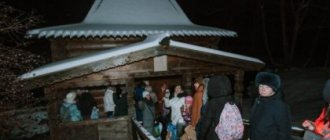| Trinity-Odigitrievsky Monastery of Zossimova Pustyn |
Moscow Trinity-Odigitrievsky stauropegial convent of Zosimova Monastery
of the Russian Orthodox Church
- Address: Russia, 108805, Moscow, Novofedorovskoye settlement, pos. Zosimova Pustyn
- Tel.
- Official site:
- On the map: Yandex.Map, Google map (no exact coordinates)
In 1826, near Moscow, on a plot of land in Vereisky district donated by the landowner Maria Semyonovna Bakhmeteva, Elder Zosima (Verkhovsky) with the blessing of Metropolitan Philaret of Moscow founded a women's community in honor of the Smolensk Icon of the Mother of God “Hodegetria”.
The community included the spiritual daughters of the elder - nuns who had previously been nuns of the St. Nicholas Monastery in Turinsk, Tobolsk province. In 1838, the Church of the Life-Giving Trinity was built over the grave of Elder Zosima (Verkhovsky).
In 1856, the women's community was transformed into a monastery. At that time, there were three churches on the territory of the monastery - the Church of the Life-Giving Trinity, the refectory Church of the Nativity of John the Baptist and the gateway in honor of the Hodegetria icon of the Mother of God.
Under Soviet rule, the monastery was abolished, but the nuns were not immediately evicted. Abbess Afanasia (Lepeshkina) was able to unofficially preserve the monastery for another ten years by registering the agricultural artel “Zosima Pustyn” with the land committee.
In 1929 the monastery was closed. Abbess Afanasia was arrested and exiled to Kazakhstan. A home for the disabled was placed on the territory of the monastery, and then a pioneer camp for the Moscow Metro. Many buildings were destroyed. A club was set up in the building of the Trinity Church. The bell tower was used as a water tower.
In 1999, the territory of the Zosimova Hermitage was returned to the Church as a courtyard of the Novodevichy Convent in Moscow.
On March 7, 2000, by decision of the Holy Synod, the metochion was transformed into the Trinity-Odigitrievskaya Zosima Hermitage [1].
In 2012, in connection with a change in the border between the city of Moscow and the Moscow region, the Trinity-Odigitrievskaya Zosimova Hermitage was transferred to the canonical subordination of the Patriarch of Moscow and All Rus' as the diocesan bishop of the city of Moscow.
LiveInternetLiveInternet
Quote from Bual's message
Read in full In your quotation book or community!
St. Smolensk Zosimova men's hermitage.
The Smolensk Zosimova Hermitage was one of the ascribed hermitages and hermitages around the Trinity-Sergius Lavra. Tradition names Schemamonk Zosima, who labored at the end of the 17th century, as the founder of the men's hermitage. After the death of the schema-monk in the middle of the 18th century. the monastery ceased to exist. Several attempts to revive it were unsuccessful. Only in 1848 was a wooden chapel erected over the grave of Schemamonk Zosima. In 1867, the hermitage was revived by the monks of the Trinity-Sergius Lavra, to which it was assigned.
The Gate Church was built over the Holy Gates of the monastery. On the eastern side, at the expense of Grand Duchess Elizabeth Feodorovna, a cell building, the so-called “senile” building, was built.
The brief flourishing experienced by the Smolensk Zosimova monastery at the end of the 19th and beginning of the 20th centuries constitutes a separate chapter in itself in the annals of Russian monasticism and the Russian Church in general. But Zosimova's hermitage did not bloom out of nowhere. It was nourished by deep traditions of holiness that took root here in the 17th century.
Photo of the late 19th century
In 1899, a book about the Smolensk Zosimova Hermitage was published in Moscow, written by the future metropolitan, hieromartyr, and then still hieromonk Seraphim (Chichagov). “Two hundred years ago, in the former Pereyaslavl-Zalessky, in the Kinelsky camp, on the hilly bank of the small river Molokhchi, there was a forest wasteland with small clearings overgrown with grass, called Ulyanina and significantly removed from human habitation. Not without the will of God, on a day unknown to us, a certain elder Zosima visited this wasteland, called by God to a solitary, hermit life. The old man liked this desert. A beautiful, centuries-old forest, a winding river and the deepest silence, interrupted only by the singing and shouting of birds. The blessed elder prayed, asked for the revelation of God’s will, and, knowing in his pure heart that this particular place was intended for him for asceticism and desert living, he remained here forever.”
As the years passed, the brethren gathered around the elder - although very few in number (tradition preserved the names of only the monks Jonah and Cyril) - vegetable gardens and cells appeared. The pilgrims flocked to the desert. There were also representatives of noble families among them. Elder Zosima was deeply revered by Princess Natalia Alekseevna, sister of Peter I. Through her efforts, the chapel grew and was decorated in the desert. After the death of Zosima's father, his students and employees went their separate ways. The chapel, built by the monks, was assigned to the Lucian Hermitage, located near Alexandrov. There is some information that in 1728 the Zosimov Hermitage was restored, the Hieromartyr Seraphim (Chichagov) mentions the name of one of its builders at that time - Hieromonk Joachim - but in the notorious year 1764 it was closed again, and the chapel and all the poor property were included in the parish church of the village Nikulsky.
The main temple of the monastery. Built on the burial site of the saint. Zosima of Vladimir, founder of the desert. In the Cathedral the relics of St. Zosima Vladimirsky and Rev. Herman and Alexy Zosimovsky, there is a revered icon of the Mother of God of Smolensk (Hodegetria).
View of the temple in the second half of the 19th century
Modern decoration of the temple.
In the future, much greater sorrows awaited the deserts. Elder Simeon Ermolaev, who collected information about Schemamonk Zosima in the mid-19th century, described this mournful period as follows: “The chapel or cell in which Father Zosima lived was empty, but many people flocked to his grave, on which a large monument made of white stone was erected... to the people... and now funeral services were served, which were served by the priest of the village of Nikulskoye, to whose parish the desert belonged. The priest of the village of Slotina, Father Jacob, was very jealous of the income that the priest of the village of Nikulskoye received from funeral services, and therefore he came to the owner of this desert, Mr. Simonov, and persuaded him to take the images out of the chapel and transfer them to the church of the village of Slotina, which happened; also, a monument was removed from the grave of Elder Zosima and transported by the priest (who was cutting off the inscription with an ax) to the village of Slotino... The chapel of Mr. Timonov was turned into a poultry house, and when they had arranged the peckers and everything necessary, they transferred all the poultry and two pigs to a new poultry house. But what was the astonishment of the poultry lady when she woke up the next day and saw the pigs and all the birds dead... They say it was in 1798.” Soon after this, the landowner Timonov also died, and since he was childless, after the death of his widow Ulyanina, the wasteland went to other owners and over the next decades passed from hand to hand more than once.
The chapel, which Timonov had so recklessly turned into a poultry house, according to Elder Simeon, had completely collapsed during this time, and now only a simple wooden cross reminded of the burial place of Father Zosima. But the local residents did not forget about the saint of God lying under this cross, and still came here. In 1848, through the efforts of the widow of the Alexandrovsky merchant I.F. Baranov, who acquired the forest of the Ulyanina Heath for felling, a chapel appeared again in the Zosimova Hermitage. As a result, pilgrimage to the holy place became more active, but the first steps towards the revival of monastic life here were taken only in 1866, when the landowner G.I. Nettel, who at that time owned the land on which the chapel and grave of Elder Zosima were located, drew up a deed of gift for it , having the desire to donate land to the Trinity-Sergius Lavra. The petition she submitted to the Lavra Cathedral stated that she “donates three tithes, with the spruce and birch forest growing on this (land - editor’s note) and a chapel, for the service of prayers and memorial services for Schemamonk Zosima in this last brethren of the monastery , buried at the chapel, wishing from the inhabitants of the surrounding villages.”
Mrs. Nettel managed to fulfill her intention, however, only three years later, but soon other owners of nearby lands followed her example. As a result, ten acres of land were donated to the reviving monastery. Blessed Philippushka from the Lavra brethren took a close part in the restoration of the Zosimova Hermitage.
General view of the monastery in the 19th century. By the time serious work on the improvement of the monastery began, he himself had already died, and the work begun was continued by his son Procopius (in monastic vows - Porfiry). The works of Philippushka and Porfiry, as noted by monk Aristoclius, a modern historiographer of the desert, “were constantly hampered by almost detective stories that arose over the course of two decades around the Zosimova Hermitage. It’s enough to cite the fact that the holy fool accused her of printing counterfeit money in her caves!”
The rumor about counterfeit credit notes, which spread in 1867, even led to a search in Filippushka’s cell. Of course, nothing reprehensible was found in it, but Metropolitan Filaret (Drozdov), who knew and revered the blessed one closely, blessed him to temporarily move to another monastery. Philippushka obeyed the archpastor, and died in 1868. Only in 1889, thanks to the prayers of Father Porfiry and the zeal of the Shaposhnikov merchant family, a stone church was erected over the grave of Elder Zosima, consecrated in honor of the shrine that was once brought to this place by a desert dweller - the Smolensk Icon of the Mother of God. In 1890, D. M. Shaposhnikov, at his own expense, built a building for the monastic brethren in the desert. For some time, the status of the Zosimova Hermitage remained uncertain, and its financial situation was not very comforting. But soon the Lord sent her an organizer, ready to work for her good not only out of duty, but out of spiritual attraction. He became Archimandrite Pavel (Glebov), who in 1891 was appointed vicar of the Trinity-Sergius Lavra.
“Touring all the monasteries subordinate to the Lavra,” writes Hieromartyr Seraphim (Chichagov), “he also visited the Zosima Hermitage. The wretched appearance of the desert made a strong impression on him. The monastery had no fence and was completely open. The temple, which constituted the unspeakable joy of the desert, was essentially cramped and long, since it was formed from a chapel, to which a porch and a refectory were added. In winter, the thin glass of the chapel froze; it was damp; the floor lay on the ground itself. The general appearance of the desert, in which there was only one building for cells and then three old huts, involuntarily made one think about the situation of the monastics and want to bring all possible help. When Father Vicar celebrated a memorial service in the church at the grave of Schemamonk Zosima, he already felt in his heart an irresistible desire to become the organizer of this suffering monastery.” Almost immediately, Archimandrite Pavel began to seek materials and funds for the construction of a stone fraternal building, then a benefactor appeared who wished to give a donation for the construction of a new cathedral church. In just a few years, the development of the desert has advanced as much as it has not advanced in all the past decades.
In 1897, by decree of Metropolitan Sergius (Lyapidevsky) of Moscow and with the blessing of Archimandrite Paul, Hieromonk Herman (Gomzin), a resident of the Lavra Gethsemane monastery, was appointed rector of Zosima Hermitage. Several novices came with him to the desert, forming the backbone of the Zosimov brethren. By the 1910s, its number increased to one hundred people, the monastery acquired a beautiful architectural ensemble and turned into one of the all-Russian shrines: the most prominent figures of the Church, representatives of aristocratic families and the intelligentsia enjoyed the spiritual care of the local elders. Zosimova Monastery seemed to have taken the baton from Optina, where at that time the lamps of the Russian eldership were extinguished one after another - St. Ambrose (+1891), Anatoly (+l894), Isaac (+l894), Joseph (+l911), Barsanuphius (+1913) ...
In the description of the Zosimova Hermitage, compiled by the Hieromartyr Seraphim (edition of 1913), the life of the monastery during its heyday is illuminated in this way: “The brethren live following the example of St. fathers, under the guidance of the elders, revealing to them daily their thoughts and sins, listening to experienced instructions and instructions. The number of brethren extends to one hundred people, 14 hieromonks, 8 hierodeacons, 18 ryassophores, 20 monks and up to 40 people. novices. The treasurer is Hieromonk Mitrofan, and the dean is Hieromonk Melchizedek.
Characteristic features of the asceticism of the Zosima Hermitage: long services in the temple, on weekdays the Sarov rule with “smart” prayer and bows, strict obedience not out of fear, but out of conscience and tireless work. All obediences up to fifteen: day and night the Psalter is read for benefactors, they serve in the temple, they paint icons, they engage in turning, they do carpentry, they bind books, they bake prosphora, they bake bread, they work in the kitchen, they sew clothes, they do painting work, in the forge, in in the barnyard, in the metal shop, they are tinning dishes.
Modestly, silently and resignedly, the inhabitants of the Zosima Monastery carry out their feat, caring not about worldly needs, but about the only thing they need. Almost everything necessary is handled by the hands of the brethren; no one is an exception when performing work; everyone works led by the abbot, who by his own example teaches the brethren vigilance, prayer and prayer, remembering the precept of John Chrysostom that “the most effective teaching comes from example.”
The chapel that has not survived On January 17/30, 1923, the schema-abbot of Zosimova Hermitage, the Monk Herman, died. This mournful date is significant for the history of the monastery, since Fr. Herman predicted that the monastery would not be closed during his lifetime. And the clouds were already gathering. The Lavra and many monasteries of the Moscow and Vladimir dioceses ceased to exist. After the death of St. Herman, the turn of Zosimova Hermitage came. The Bolsheviks dispersed it on one day - on Ascension Day, which in 1923 fell on May 6, old style. The brethren scattered. The destinies of some were now connected with the Vysoko-Petrovsky Monastery, where the spiritual son of St. Herman Bishop Bartholomew (Remov), others settled near the closed desert and the Lavra (in particular, the famous elder Alexy (Soloviev) lived in Zagorsk until his death. In the coming years, most of them were destined to set foot on the thorny path of martyrdom and confession. And in the desecrated Zosima Monastery, an orphanage was located. He ruled here for a short time, giving way to a much more “durable” resident - a military unit. The monastery buildings were converted into housing for officers and their families, a club was set up in the Smolensk Cathedral. But this stage of the monastery’s difficult history is gradually becoming a thing of the past.
The monastery walls are almost entirely preserved today.
Gate bell tower at the end of the 19th century.
Modern view of the gate bell tower.
Modern view of the gate bell tower.
A partially preserved inscription from the Soviet period on the gate church-bell tower.
In 1992, the first monks came to Zosima Hermitage. March 15, 1992 with the Decree of Bishop (now Metropolitan) of Vladimir and Suzdal Evlogii on the opening of the monastery and the resumption of monastic life in it. The revival of the monastery began. In July 1994, the canonization of the founder of the monastery, Schemamonk Zosima, took place (for church-wide glorification, commemorated on June 28 and July 26)
A preserved tombstone from the grave of the founder of the monastery, Schemamonk Zosima.
The other day we visited the St. Smolensk Zosimova Men's Hermitage. The monastery is revived and becomes a full-fledged monastery. But alas, ordinary people still live in the buildings where the monks’ cells should be. Previously, the entire territory belonged to the military, and even now it is probably partially occupied by the military. The living conditions in these houses are not very good, but not everything has been given to the monastery yet, and apparently they cannot resettle people into new housing.
This is what the entrances of residential buildings look like, where monastic cells should be located.
The text about the history of the St. Smolensk Zosimova Hermitage was taken from the monastery website - Source
Modern photos are mine.
Infrastructure
On the territory of the desert there are two temples: the Holy Trinity - the main church of the monastery; Church of the Nativity of John the Baptist, located in the bell tower. Regular services and rituals are performed in the Church of the Holy Trinity. It is open daily from 8:00 to 19:00. The Church of John the Baptist is not heated, so services are held here once a year.
There is a subsidiary farm on the monastic territory. It includes: a cowshed, several beehives, a chicken coop and a vegetable garden. Baking and prosphora are being prepared. The monastery actively helps the shelter for children and disabled people.
In March 2022, the Zosimova Hermitage Museum began operating on the territory of the monastery. There are three halls, each of which represents a certain time period.
The monastery has the ability to accommodate pilgrim groups of up to 15 people for the night. The hotel accommodates two cells: a women's cell for 8 places and a men's cell for 7 places.
Bell tower of Zosimova Hermitage, © sprint123
Shrines
The martyr Tryphon is especially revered in the monastery. On Wednesdays, an akathist is read in honor of this saint. Between Zosima and the central limits there is a cast bronze arm in which the relics of St. Zosima . They emit a fragrance with different intensities: sometimes obvious, sometimes barely perceptible.
The Smolensk Icon of the Mother of God hangs in the Church of the Holy Trinity . The first image was written by the apostle and evangelist Luke. It was this icon that laid the foundation of the Zosima Hermitage. With her, the monk Zosimus came to new lands to found a monastery.
Interior decoration of Trinity Church, © sprint123
Stamps in philately
For the first time, the word “philately” (from the Greek “philio” - love and “ately” - exemption from payment) and “philatelist” were published in the French magazine “Stamp Collector” in 1864.
There are two main directions in philately: traditional (classical) and thematic. Traditional philately is the collecting and systematization of postage stamps from one or more countries, in chronological order, according to catalogs. In our country, most adherents of traditional philately collect the chronology of uncanceled stamps of Russia. Cancelled stamps are less commonly collected. The objects of thematic philately, in contrast to traditional ones, are stamps from different countries on a chosen topic: flora, fauna, art, transport, space, sports, science and technology, etc.
Issue of stamps today
JSC "Marka" publishes postage stamps of the Russian Federation, providing them to all post offices and philatelic salons "Collector". In 1857, the Postal Department of the Russian Empire established the Stamp Expedition, which was responsible for issuing the first stamps of the Russian Empire. It is from this moment that the current joint stock company “Marka” traces its history. Today, Marka JSC, in partnership with Goznak JSC, issues an average of one hundred and fifty postage stamps with various subjects annually.
Since 2001, Marka JSC has repeatedly published truly unique postal miniatures. Among them are postage stamps with foil stamping from 22 and 24 carat gold and silver, postage stamps with hidden text, aromatic coating, imitation of various coatings, augmented reality. One of the important activities of Marka JSC is the organization of joint postal issues with different countries. Postal miniatures created by Marka JSC take prizes at world and international competitions, as well as major philatelic exhibitions and forums.
ZOSIMOV IN THE NAME OF THE HOLY TRINITY AND IN HONOR OF THE SMOLENSK ICON OF THE MOTHER OF GOD “HODEGETRIA” WOMEN’S DESERT
To the beginning In 1919, there was a “labor community” in Z. (TsGAMO. F. 689. D. 27. L. 16), cut on January 31. 1920 it was proposed to “develop a charter, submitting it with a list of those included in the labor community to the district department for approval for registration.” The list indicated 206 former nuns. mon-rya, 18 refugees and 9 members of families of priests (TsGAMO. F. 690. Op. 1. D. 7. L. 26-29). Oct 26 In 1920, the abbot was chosen as the chairman of the artel. Afanasia (Lepyoshkina), who preserved the monastic system of life among the sisters - employees of the artel.
Zosimova Hermitage. Photo. 2004 Zosimova Pustyn. Photo. 2004. In the inventory of property of 1920 and in the formal list of property compiled in March 1921, all monastery buildings were listed as belonging to the artel (Ibid. L. 63-64; F. 4997. Inventory 1. D. 717. L. 1-15). However, following. fuel crisis of 1921 in the forests of Rudnevskaya vol. Moskvotop detachments were working (units for procuring fuel for Moscow), and all 2-story buildings of the plant were occupied by Moskvotop workers. “The oppression of artel members was beyond the limits of sanitary norms” (Ibid. D. 1367. L. 24-27). After the Moscow Top workers left, the brick buildings of the monastery were transferred to Invalid Home No. 9. In 1920, the artel processed 10.5 dessiatines. land, in 1921 - 22 dessiatines. During the 1922 campaign to confiscate church valuables from the churches of Z., 3 pounds 35 pounds 47 spools of silver were taken out, which amounted to a third of all silver seized in the Naro-Fominsk region.
The sisterhood of workers existed not only within the framework of the labor artel. After Aug. 3. 1922 The All-Russian Central Executive Committee issued a decree allowing believers to organize into religions. monastery, an application was submitted for registration of a religious society at the churches of Z. p. According to this document, priests Mikhail Vinogradov and Dimitry Rozanov served in the churches of the monastery. The agreement was signed on March 22, 1924 (Ibid. F. 2457. Op. 1. D. 42. L. 18-33). Inspector of the Moscow region land department (Ibid. F. 719. Op. 1. D. 268. L. 276). Meeting to review the collectives of the Moscow province. On March 24, 1925, with the participation of a representative from the GPU, it was decided to “preserve the artel, subject to reorganization by excluding from the artel monastics who do not have voting rights, and changing the way of life” (Ibid. L. 327). In 1928, the “labor agricultural artel of Zosimov Pustyn” consisted of 166 people. (Ibid. F. 718. Op. 1. D. 324. L. 19).
By resolution of the Presidium of the Moscow Council dated December 28. In 1928, the artel was liquidated (Ibid. F. 66. Op. 19. D. 346-A. L. 1, 2). According to contemporaries, in May 1929 the nuns were expelled by the police, settled in the vicinity of the monastery, did handicrafts, and helped peasants in the fields in the summer. In 1931-1932 56 sisters, priests M. Vinogradov and D. Rozanov were repressed and sentenced to exile in forced labor camps, but for the majority the camp was replaced by deportation to Kazakhstan. The names of 7 sisters who returned from the camps and 10 who returned from exile in Kazakhstan are known. Abbot, arrested on May 25, 1931. Afanasia (Lepyoshkina) died in exile in Kazakhstan. The prmts., who left with the abbess at her own request. Evdokia (Buchineva) died the day after being abbess. Prmts. Maria (Portnova) was arrested on May 21, 1931, exiled to Kazakhstan, lived in Pavlodar, September 25. 1937 was arrested a second time and shot. Prmts. Magdalena (Zabelina) settled in the village in May 1929. Novinskaya near Naro-Fominsk. On May 22 of the same year, together with 3 sisters who lived with her, she was arrested and exiled to Kazakhstan, where she died.
Sschmch. Mikhail Vinogradov served in the Z. p. until 1930, then in the Znamenskaya Church. village Lisintsevo, Naro-Fominsk district. In May 1931 he was arrested, exiled to Alma-Ata, died on May 31, 1932. Dimitry Rozanov, who served in the Z. p. since 1914, first as a supernumerary, and since 1915 as a full-time priest, was the “secretary” of the religious society, which was registered on March 22, 1924 at the churches of the former. mon-rya. In 1929, when the artel was finally liquidated, Fr. Demetrius served in the not yet closed Trinity Church. In May 1931 he was arrested, exiled to Kazakhstan, upon his return after 1935 he served in the Sorrow Church in the village. Fedorovsky Volokolamsk district, from February. 1937 - in the church of the village. Novovasilievskoye, Lotoshinsky district. On Sept. the same year he was arrested again and executed on October 9. at the Butovo training ground.
Since 1929, the territory of the village was occupied by Invalid House No. 9. In 1933, a club was built in the Trinity Church, a water tower and a warehouse were built in the bell tower, and in 1945, the Odigitrievsky Church was finally destroyed. During the Great Patriotic War, former. the monastery served as a hospital for wounded pilots from the neighboring airfield in Sotnikov, and after 1945 war invalids were housed in one of the buildings. Since 1968, a pioneer camp of the Moscow Metro was located on the territory of the Z. p. 14 Jan In 1982, the buildings of the Z. p. were included in the “List of architectural monuments identified in 1982.” as “an interesting example of a small provincial monastic complex in Ser. XIX - early XX century." At the initiative of the public, the Moscow Metro Administration September 22. 1995 signed protective obligations (No. 42-95) before the Committee on Culture of the Russian Federation for the historical and cultural monument “Zosimova Pustyn”.
Where to buy postage stamps
Our products can be ordered in the online store rusmarka.ru with delivery throughout Russia and the Collector chain of salons. The price of stamps corresponds to their face value. The online store of JSC "Marka" is also a catalog of stamps, in which you can see all issues of Russian stamps since 1992.
For the convenience of our customers, subscription services have been organized in the online store and the network of salons of Marka JSC. Subscription service guarantees receipt of all philatelic products released during the period specified in the subscription and in the volume specified in the subscription. By signing up for a subscription, you eliminate the possibility of gaps in your collections. Replenish your collections with Marka JSC!
Artistic postage stamps
Artistic postage stamps (commemorative) are issued for memorable dates and reflect the cultural and historical heritage, the main events of domestic and international life, the achievements of mankind in all fields of knowledge, the rich flora and fauna of our country. The circulation of art stamps is limited and additional printing is not done.
Due to their diversity and artistic value, commemorative postage stamps are becoming the main collection material for philatelists - postage stamp collectors.
